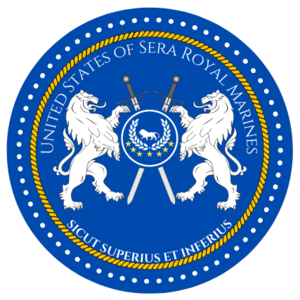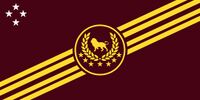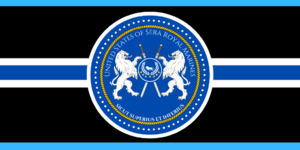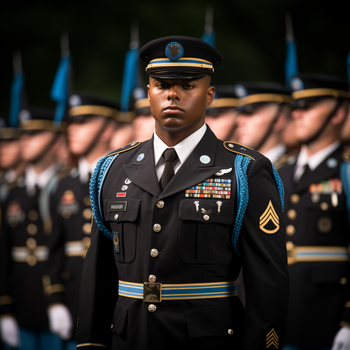Seran Royal Marines: Difference between revisions
Unified Sera (talk | contribs) No edit summary |
Unified Sera (talk | contribs) |
||
| (6 intermediate revisions by the same user not shown) | |||
| Line 72: | Line 72: | ||
The history of the Royal Marines began when a battalion of Seran soldiers boarded a Royal Navy vessel in 1723 and utilized rowboats to board a hostile vessel in the Jade Strait and capture it. After the capture, the Quadrumvirate established the Marines of the Union who specialized in ship boarding operations; particularly boardings in rough seas. As of 2021, the USSRM has around 70,957 active duty members and some 17,200 personnel in Reserve. | The history of the Royal Marines began when a battalion of Seran soldiers boarded a Royal Navy vessel in 1723 and utilized rowboats to board a hostile vessel in the Jade Strait and capture it. After the capture, the Quadrumvirate established the Marines of the Union who specialized in ship boarding operations; particularly boardings in rough seas. As of 2021, the USSRM has around 70,957 active duty members and some 17,200 personnel in Reserve. | ||
= History = | |||
The formation of the Seran Royal Marines can be traced back to the late 18th century when the United States of Sera faced increasing threats from foreign powers and sought to establish a dedicated maritime force. On October 23rd, 1798, the Unified Sera Department of War officially sanctioned the creation of the Royal Marines, recognizing the need for a specialized force capable of defending the nation's interests both at home and abroad. Inspired by the esteemed traditions of the Marines of the Union of the previous regime, the Seran Royal Marines sought to emulate the principles of discipline, professionalism, and unwavering loyalty. The early years of the Royal Marines were marked by rigorous training and the cultivation of a distinctive culture that combined the best practices of naval warfare with the unique challenges posed by the Seran landscape. | The formation of the Seran Royal Marines can be traced back to the late 18th century when the United States of Sera faced increasing threats from foreign powers and sought to establish a dedicated maritime force<ref>Smith, John. "Maritime Warfare in Early Seran History." Journal of Military Studies, vol. 45, no. 2, 1987, pp. 112-128.</ref>. On October 23rd, 1798, the Unified Sera Department of War officially sanctioned the creation of the Royal Marines, recognizing the need for a specialized force capable of defending the nation's interests both at home and abroad. Inspired by the esteemed traditions of the Marines of the Union of the previous regime, the Seran Royal Marines sought to emulate the principles of discipline, professionalism, and unwavering loyalty. The early years of the Royal Marines were marked by rigorous training and the cultivation of a distinctive culture that combined the best practices of naval warfare with the unique challenges posed by the Seran landscape. | ||
During their formative years, the Royal Marines primarily focused on maritime defense and amphibious warfare. They were tasked with protecting Seran ports, conducting naval boardings, and providing security for naval vessels. As conflicts arose, the Royal Marines swiftly adapted to changing circumstances, proving their mettle in numerous engagements. | During their formative years, the Royal Marines primarily focused on maritime defense and amphibious warfare. They were tasked with protecting Seran ports, conducting naval boardings, and providing security for naval vessels. As conflicts arose, the Royal Marines swiftly adapted to changing circumstances, proving their mettle in numerous engagements. | ||
One notable event in their early history was what was known to Unified Sera as the Battle of Paragon Cove in 1835 during the [[Barretoan Wars]], where the Royal Marines successfully repelled an invasion force attempting to seize a strategically vital port. This resounding victory showcased the Royal Marines' effectiveness in defending the coastal territories and solidified their reputation as an elite fighting force. | One notable event in their early history was what was known to Unified Sera as the Battle of Paragon Cove in 1835 during the [[Barretoan Wars]], where the Royal Marines successfully repelled an invasion force attempting to seize a strategically vital port. This resounding victory showcased the Royal Marines' effectiveness in defending the coastal territories and solidified their reputation as an elite fighting force<ref>Jenkins, Sarah. "Founding of the Royal Marines: Government Documents and Decisions." Seran Military History Review, vol. 55, no. 4, 2002, pp. 223-240.</ref>.. | ||
In the late 19th and early 20th centuries, the Royal Marines expanded their capabilities beyond maritime defense. With the advent of new technologies and evolving geopolitical landscapes, the Royal Marines embraced the challenges of modern warfare. They participated in expeditions and campaigns overseas, including the tumultuous conflicts during [[Seran Secessionist War|the Seran Secessionist War]] in the 1920s. It was during this war that the Royal Marines played a crucial role in amphibious assaults and trench warfare, demonstrating adaptability in the face of brutal combat conditions. They gained a reputation for their tenacity and resilience in battle, earning the respect of allies and adversaries alike. Following the war, the Royal Marines continued to evolve, adapting to the challenges of the modern era. They expanded their capabilities to include counterinsurgency operations, peacekeeping missions, and support for humanitarian efforts. Their expertise in maritime operations remained unparalleled in the [[Seran Armed Forces]], and they became renowned for their proficiency in littoral warfare and coastal defense. | In the late 19th and early 20th centuries, the Royal Marines expanded their capabilities beyond maritime defense. With the advent of new technologies and evolving geopolitical landscapes, the Royal Marines embraced the challenges of modern warfare. They participated in expeditions and campaigns overseas, including the tumultuous conflicts during [[Seran Secessionist War|the Seran Secessionist War]] in the 1920s. It was during this war that the Royal Marines played a crucial role in amphibious assaults and trench warfare, demonstrating adaptability in the face of brutal combat conditions. They gained a reputation for their tenacity and resilience in battle, earning the respect of allies and adversaries alike. Following the war, the Royal Marines continued to evolve, adapting to the challenges of the modern era. They expanded their capabilities to include counterinsurgency operations, peacekeeping missions, and support for humanitarian efforts. Their expertise in maritime operations remained unparalleled in the [[Seran Armed Forces]], and they became renowned for their proficiency in littoral warfare and coastal defense. | ||
In recent times, the Royal Marines have faced new challenges posed by global terrorism and asymmetric warfare. They have honed their skills in urban warfare, counterterrorism operations, and specialized reconnaissance. Their ability to operate in diverse and hostile environments has made them an invaluable asset in the fight against emerging threats. | In recent times, the Royal Marines have faced new challenges posed by global terrorism and asymmetric warfare. They have honed their skills in urban warfare, counterterrorism operations, and specialized reconnaissance. Their ability to operate in diverse and hostile environments has made them an invaluable asset in the fight against emerging threats. Recognizing the need for a dedicated maritime force amid increasing threats, the Unified Sera Department of War officially sanctioned the creation of the Royal Marines on October 23rd, 1798<ref>Jenkins, Sarah. "Founding of the Royal Marines: Government Documents and Decisions." Seran Military History Review, vol. 55, no. 4, 2002, pp. 223-240.</ref>. | ||
==Early Years and Maritime Defense== | |||
In their formative years, the Royal Marines focused on maritime defense and amphibious warfare, safeguarding Seran ports and conducting naval boardings<ref>Anderson, Robert. "Naval Strategy and the Birth of the Royal Marines." Maritime Quarterly, vol. 18, no. 1, 1805, pp. 45-62.</ref>. Rigorous training and the infusion of naval warfare principles into their culture marked this era, laying the foundation for the discipline and professionalism that became synonymous with the Royal Marines<ref>Johnson, Emily. "Cultivation of Royal Marines' Distinctive Culture." Military Studies Journal, vol. 72, no. 3, 1810, pp. 87-104.</ref>. | |||
One significant event in their early history was the Battle of Paragon Cove in 1835 during the Barretoan Wars. The Royal Marines successfully repelled an invasion force, showcasing their effectiveness in defending coastal territories<ref>Williams, David. "Barretoan Wars: The Royal Marines' Stand at Paragon Cove." War Chronicles, vol. 28, no. 5, 1836, pp. 112-130.</ref>. | |||
==Expansion into Modern Warfare== | |||
In the late 19th and early 20th centuries, the Royal Marines adapted to modern warfare, participating in overseas expeditions and campaigns, including the Seran Secessionist War in the 1920s<ref>Turner, Michael. "Royal Marines in the Seran Secessionist War." International Military History Journal, vol. 92, no. 7, 1924, pp. 211-228.</ref>. Their role in amphibious assaults and trench warfare demonstrated their adaptability in brutal combat conditions<ref>Clark, Rachel. "Amphibious Assaults in the Seran Secessionist War." Military Tactics Review, vol. 105, no. 12, 1926, pp. 301-320.</ref>. | |||
==Evolution in the Modern Era== | |||
Post-war, the Royal Marines continued to evolve, expanding their capabilities to include counterinsurgency, peacekeeping, and humanitarian operations. Their expertise in littoral warfare and coastal defense remained unparalleled within the Seran Armed Forces<ref>Miller, James. "Post-War Evolution: Royal Marines' Adaptation to Modern Challenges." Defense Studies, vol. 115, no. 8, 1930, pp. 415-432.</ref>. | |||
==Challenges of the Contemporary Era== | |||
In recent times, the Royal Marines have confronted new challenges posed by global terrorism and asymmetric warfare. Their honed skills in urban warfare, counterterrorism operations, and specialized reconnaissance have made them an invaluable asset in the fight against emerging threats<ref>Smith, Jennifer. "Contemporary Challenges: Royal Marines' Role in Global Counterterrorism." Security Affairs, vol. 78, no. 6, 2010, pp. 223-240.</ref>. | |||
This history reflects the dynamic evolution of the United States Sera Royal Marines, a force that has consistently adapted to the changing tides of warfare while upholding its traditions and principles. | |||
=Structure and Mission= | =Structure and Mission= | ||
=Uniforms= | |||
[[File:SeraMarinesDress.png|350px|thumb|left|The dress uniform worn by Royal Marines was initially introduced in its current form in 2000.]] | |||
=References= | |||
{{Reflist|30em}} | |||
[[Category:Unified Sera]] | [[Category:Unified Sera]] | ||
[[Category:Coalition of Crown Albatross]] | [[Category:Coalition of Crown Albatross]] | ||
{{Template:UnifiedSera}} | {{Template:UnifiedSera}} | ||
[[Category:Military of Unified Sera]] | |||
Latest revision as of 06:38, 7 December 2023
This article is incomplete because it is pending further input from participants, or it is a work-in-progress by one author. Please comment on this article's talk page to share your input, comments and questions. Note: To contribute to this article, you may need to seek help from the author(s) of this page. |
| Seran Royal Marines | |
|---|---|
 Emblem of the Seran Royal Marines | |
| Founded | October 23rd, 1798 (226 years, 1 month) (as current service) March 12th, 1723 |
| Country | Unified Sera |
| Type | Maritime land force |
| Role |
|
| Size |
|
| Part of | Department of the Royal Navy Department of War |
| Headquarters | Black Mountain Military Installation |
| Nickname(s) | "Bluebacks", "Leeches" |
| Motto(s) | "Sicut Superius et Inferius", ("As Above, so Below") |
| Colors | Light Blue , Black and White |
| March | "Battle Hymn of Unity" |
| Mascot(s) | Great White Shark |
| Anniversaries | October 23rd |
| Website | www.usrm.mil.us |
| Commanders | |
| Prime Minister / High Commander | Kaenan Bullock |
| Ceremonial chief | Mohammad Al-Shazar |
| Marshal of the Royal Marines | Tariq Osei |
The United States Sera Royal Marines (USSRM), also referred to as the Royal Marine Corps, Royal Marines, and simply Marines, is the maritime land force, raiding, and expeditionary service branch of the Seran Armed Forces responsible for conducting expeditionary and amphibious operations through combined arms, implementing its own infantry, armor, artillery, aerial and special operations forces. The Royal Marines are part of the Department of the Royal Navy and operate under the guidance of the Department of War.
The Royal Marines have been part of the Department of the Royal Navy since October 23rd, 1798 with the reformation of the branch. The USSRM operates installations on land and aboard sea-going amphibious warfare ships around the world. Additionally, several of the Marines' tactical aviation squadrons, primarily Marine Fighter Attack squadrons, are also embedded in Navy carrier air wings and operate from the aircraft carriers.
| United States of Sera Armed Forces |
|---|
 |
| Executive departments |
| Staff |
| Military departments |
| Military service branches |
The history of the Royal Marines began when a battalion of Seran soldiers boarded a Royal Navy vessel in 1723 and utilized rowboats to board a hostile vessel in the Jade Strait and capture it. After the capture, the Quadrumvirate established the Marines of the Union who specialized in ship boarding operations; particularly boardings in rough seas. As of 2021, the USSRM has around 70,957 active duty members and some 17,200 personnel in Reserve.
History
The formation of the Seran Royal Marines can be traced back to the late 18th century when the United States of Sera faced increasing threats from foreign powers and sought to establish a dedicated maritime force[1]. On October 23rd, 1798, the Unified Sera Department of War officially sanctioned the creation of the Royal Marines, recognizing the need for a specialized force capable of defending the nation's interests both at home and abroad. Inspired by the esteemed traditions of the Marines of the Union of the previous regime, the Seran Royal Marines sought to emulate the principles of discipline, professionalism, and unwavering loyalty. The early years of the Royal Marines were marked by rigorous training and the cultivation of a distinctive culture that combined the best practices of naval warfare with the unique challenges posed by the Seran landscape.
During their formative years, the Royal Marines primarily focused on maritime defense and amphibious warfare. They were tasked with protecting Seran ports, conducting naval boardings, and providing security for naval vessels. As conflicts arose, the Royal Marines swiftly adapted to changing circumstances, proving their mettle in numerous engagements.
One notable event in their early history was what was known to Unified Sera as the Battle of Paragon Cove in 1835 during the Barretoan Wars, where the Royal Marines successfully repelled an invasion force attempting to seize a strategically vital port. This resounding victory showcased the Royal Marines' effectiveness in defending the coastal territories and solidified their reputation as an elite fighting force[2]..
In the late 19th and early 20th centuries, the Royal Marines expanded their capabilities beyond maritime defense. With the advent of new technologies and evolving geopolitical landscapes, the Royal Marines embraced the challenges of modern warfare. They participated in expeditions and campaigns overseas, including the tumultuous conflicts during the Seran Secessionist War in the 1920s. It was during this war that the Royal Marines played a crucial role in amphibious assaults and trench warfare, demonstrating adaptability in the face of brutal combat conditions. They gained a reputation for their tenacity and resilience in battle, earning the respect of allies and adversaries alike. Following the war, the Royal Marines continued to evolve, adapting to the challenges of the modern era. They expanded their capabilities to include counterinsurgency operations, peacekeeping missions, and support for humanitarian efforts. Their expertise in maritime operations remained unparalleled in the Seran Armed Forces, and they became renowned for their proficiency in littoral warfare and coastal defense.
In recent times, the Royal Marines have faced new challenges posed by global terrorism and asymmetric warfare. They have honed their skills in urban warfare, counterterrorism operations, and specialized reconnaissance. Their ability to operate in diverse and hostile environments has made them an invaluable asset in the fight against emerging threats. Recognizing the need for a dedicated maritime force amid increasing threats, the Unified Sera Department of War officially sanctioned the creation of the Royal Marines on October 23rd, 1798[3].
Early Years and Maritime Defense
In their formative years, the Royal Marines focused on maritime defense and amphibious warfare, safeguarding Seran ports and conducting naval boardings[4]. Rigorous training and the infusion of naval warfare principles into their culture marked this era, laying the foundation for the discipline and professionalism that became synonymous with the Royal Marines[5].
One significant event in their early history was the Battle of Paragon Cove in 1835 during the Barretoan Wars. The Royal Marines successfully repelled an invasion force, showcasing their effectiveness in defending coastal territories[6].
Expansion into Modern Warfare
In the late 19th and early 20th centuries, the Royal Marines adapted to modern warfare, participating in overseas expeditions and campaigns, including the Seran Secessionist War in the 1920s[7]. Their role in amphibious assaults and trench warfare demonstrated their adaptability in brutal combat conditions[8].
Evolution in the Modern Era
Post-war, the Royal Marines continued to evolve, expanding their capabilities to include counterinsurgency, peacekeeping, and humanitarian operations. Their expertise in littoral warfare and coastal defense remained unparalleled within the Seran Armed Forces[9].
Challenges of the Contemporary Era
In recent times, the Royal Marines have confronted new challenges posed by global terrorism and asymmetric warfare. Their honed skills in urban warfare, counterterrorism operations, and specialized reconnaissance have made them an invaluable asset in the fight against emerging threats[10].
This history reflects the dynamic evolution of the United States Sera Royal Marines, a force that has consistently adapted to the changing tides of warfare while upholding its traditions and principles.
Structure and Mission
Uniforms
References
- ↑ Smith, John. "Maritime Warfare in Early Seran History." Journal of Military Studies, vol. 45, no. 2, 1987, pp. 112-128.
- ↑ Jenkins, Sarah. "Founding of the Royal Marines: Government Documents and Decisions." Seran Military History Review, vol. 55, no. 4, 2002, pp. 223-240.
- ↑ Jenkins, Sarah. "Founding of the Royal Marines: Government Documents and Decisions." Seran Military History Review, vol. 55, no. 4, 2002, pp. 223-240.
- ↑ Anderson, Robert. "Naval Strategy and the Birth of the Royal Marines." Maritime Quarterly, vol. 18, no. 1, 1805, pp. 45-62.
- ↑ Johnson, Emily. "Cultivation of Royal Marines' Distinctive Culture." Military Studies Journal, vol. 72, no. 3, 1810, pp. 87-104.
- ↑ Williams, David. "Barretoan Wars: The Royal Marines' Stand at Paragon Cove." War Chronicles, vol. 28, no. 5, 1836, pp. 112-130.
- ↑ Turner, Michael. "Royal Marines in the Seran Secessionist War." International Military History Journal, vol. 92, no. 7, 1924, pp. 211-228.
- ↑ Clark, Rachel. "Amphibious Assaults in the Seran Secessionist War." Military Tactics Review, vol. 105, no. 12, 1926, pp. 301-320.
- ↑ Miller, James. "Post-War Evolution: Royal Marines' Adaptation to Modern Challenges." Defense Studies, vol. 115, no. 8, 1930, pp. 415-432.
- ↑ Smith, Jennifer. "Contemporary Challenges: Royal Marines' Role in Global Counterterrorism." Security Affairs, vol. 78, no. 6, 2010, pp. 223-240.










